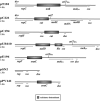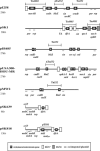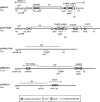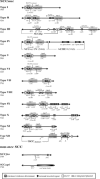Staphylococcal Plasmids, Transposable and Integrative Elements
- PMID: 30547857
- PMCID: PMC11633639
- DOI: 10.1128/microbiolspec.GPP3-0030-2018
Staphylococcal Plasmids, Transposable and Integrative Elements
Abstract
Strains of Staphylococcus aureus, and to a lesser extent other staphylococcal species, are a significant cause of morbidity and mortality. An important factor in the notoriety of these organisms stems from their frequent resistance to many antimicrobial agents used for chemotherapy. This review catalogues the variety of mobile genetic elements that have been identified in staphylococci, with a primary focus on those associated with the recruitment and spread of antimicrobial resistance genes. These include plasmids, transposable elements such as insertion sequences and transposons, and integrative elements including ICE and SCC elements. In concert, these diverse entities facilitate the intra- and inter-cellular gene mobility that enables horizontal genetic exchange, and have also been found to play additional roles in modulating gene expression and genome rearrangement.
Figures





References
-
- Kuroda M, Ohta T, Uchiyama I, Baba T, Yuzawa H, Kobayashi I, Cui L, Oguchi A, Aoki K, Nagai Y, Lian J, Ito T, Kanamori M, Matsumaru H, Maruyama A, Murakami H, Hosoyama A, Mizutani-Ui Y, Takahashi NK, Sawano T, Inoue R, Kaito C, Sekimizu K, Hirakawa H, Kuhara S, Goto S, Yabuzaki J, Kanehisa M, Yamashita A, Oshima K, Furuya K, Yoshino C, Shiba T, Hattori M, Ogasawara N, Hayashi H, Hiramatsu K. 2001. Whole genome sequencing of meticillin-resistant Staphylococcus aureus. Lancet 357:1225–1240 10.1016/S0140-6736(00)04403-2. [PubMed] - DOI - PubMed
-
- Holden MT, Feil EJ, Lindsay JA, Peacock SJ, Day NP, Enright MC, Foster TJ, Moore CE, Hurst L, Atkin R, Barron A, Bason N, Bentley SD, Chillingworth C, Chillingworth T, Churcher C, Clark L, Corton C, Cronin A, Doggett J, Dowd L, Feltwell T, Hance Z, Harris B, Hauser H, Holroyd S, Jagels K, James KD, Lennard N, Line A, Mayes R, Moule S, Mungall K, Ormond D, Quail MA, Rabbinowitsch E, Rutherford K, Sanders M, Sharp S, Simmonds M, Stevens K, Whitehead S, Barrell BG, Spratt BG, Parkhill J. 2004. Complete genomes of two clinical Staphylococcus aureus strains: evidence for the rapid evolution of virulence and drug resistance. Proc Natl Acad Sci U S A 101:9786–9791 10.1073/pnas.0402521101. [PubMed] - DOI - PMC - PubMed
Publication types
MeSH terms
Substances
LinkOut - more resources
Full Text Sources
Medical
Research Materials

